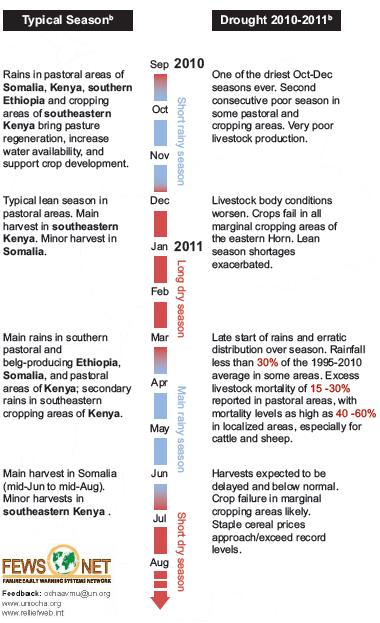|
Call for action

Amid the al Shabaab blockade, the continuing chaos and instability in Somalia are the projections by the Famine Early Warning Systems Network (FEWS-NET) and Food Security and Nutrition Analysis Unit (FSNAU), in collaboration with Food and Agriculture Organization (FAO), UNICEF and several other international agencies, that the famine could worsen and extend to December 2011, according to a document released on July 19. This has prompted a global cry for help and rekindles the memory of the devastating 1984 famine in Ethiopia.
For its part the African Union has appealed to its member states to raise resources in order to respond immediately to the situation and save lives in the Horn of Africa. A Pledging Conference on the Situation in the Horn of Africa was planned August 2011 in Addis Ababa, Ethiopia. The conference aimed to galvanize resources on the continent primarily in order to fill the funding gap, put together an emergency response, and sensitize African leaders and the international community on medium- and long-term crisis mitigation strategy.
The call for action varies. Some favor statements of facts clothed in veiled threats, while others tell it like it is, targeting the emotions of those who can and are willing to help.
Le Maire is part of the former. "Famine is a scandal in our time; it is not a scandal of yesterday, it is a scandal of today. But if we don't take appropriate measures today, it will be a scandal tomorrow," he said.
Josette Sheeran has assessed the situation on the ground and has appealed to the emotions of others. "I literally saw dozens of children who will not make it. And many of the mothers I talked to had had to leave children along the road, who were too weak to walk, in order to save the others. Others died in their arms and they left them on the road side," she told the July 25 international meeting on the drought in the region.
In this life and death situation of biblical proportions, money is needed - quickly and in huge amounts. The OCHA 2011 situation reports on Somalia show that over the next year, $1.6 billion is required. In the meantime, $300 million is needed urgently for crisis mitigation, to supply food.
The balance will be used to improve the agricultural activities, manage climate change and ensure food security. Also needed are drought resistant crops, irrigation-based agriculture, early-maturing crops, distribution of farm input like seeds and fertilizer to farmers plus a follow-up on post-harvest crop management, support to animal health through provision of drugs, vaccines and training, and food-for-work programs and cash transfers.
The relief supplies should not run indefinitely either, because they can distort local production. As focus shifts to local solutions, the hope is that this is the last of the droughts being seen in the Horn of Africa and in the world. The region should not allow pessimists and cynics to be proved right again in the next century, just as they already have the Millennium Development Goal to eradicate hunger and poverty.
|